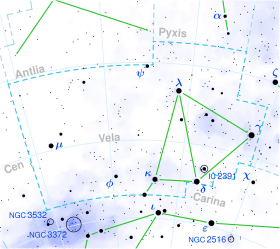Delta Velorum
| Observation data Epoch J2000 Equinox J2000 | |
|---|---|
| Constellation | Vela |
| δ Vel A | |
| Right ascension | 08h 44m 42.226s[1] |
| Declination | −54° 42′ 31.76″[1] |
| Apparent magnitude (V) | 1.99[1] (1.99 - 2.39[2]) |
| δ Vel B | |
| Right ascension | 08h 44m 42.203s[1] |
| Declination | −54° 42′ 30.60″ |
| Apparent magnitude (V) | 5.57[1] |
| Characteristics | |
| U−B color index | +0.07[3] |
| B−V color index | +0.04[3] |
| δ Vel A | |
| Spectral type | A1 Va(n)[4] |
| Variable type | Eclipsing binary[2] |
| δ Vel B | |
| Spectral type | F2-F5[5] |
| Astrometry | |
| Radial velocity (Rv) | +2.2[6] km/s |
| Proper motion (μ) | RA: +28.99[7] mas/yr Dec.: −103.35[7] mas/yr |
| Parallax (π) | 40.49 ± 0.39 mas[7] |
| Distance | 80.6 ± 0.8 ly (24.7 ± 0.2 pc) |
| Absolute magnitude (MV) | 0.02/3.60[5] |
| Details | |
| δ Vel A | |
| Mass | 2.53/2.37[5] M☉ |
| Radius | 2.643/2.363[5] R☉ |
| Luminosity | 56.3/47.1[5] L☉ |
| Surface gravity (log g) | 3.79[4] cgs |
| Temperature | 9,470/9,370[5] K |
| Rotational velocity (v sin i) | 150[8] km/s |
| Age | 400 million[5] years |
| δ Vel B | |
| Mass | 1.5[5] M☉ |
| Other designations | |
| Database references | |
| SIMBAD | data |
Delta Velorum (δ Vel, δ Velorum) is a star system in the southern constellation Vela, near the border with Carina. Based on parallax measurements, it is approximately 80.6 light-years (24.7 parsecs) from Earth. This star appears in an asterism with the given name of Koo She (Chinese: 弧矢, hú shǐ, "boe and arrows"), comprising δ Velorum and ω Velorum.[9]
The south celestial pole will pass close to δ Velorum around 9000 AD because of precession.[10]
Components
Delta Velorum is a triple star system. The outward components A and B have a wide orbit with a 142 year orbital period. The primary component A has an apparent magnitude of 1.99, while the secondary component B is magnitude 5.57, with a combined magnitude measured at 1.96.[11] In 1978 the primary component was reported to be a spectroscopic binary in the Proceeding of the Australian Astronomical observatory, and this was confirmed by the Hipparcos satellite. Observations of variability in the δ Velorum system were made independently by ground-based astronomers and the Galileo spaceprobe at Jupiter.[12]
In 2000 it was announced that the components Aa and Ab form an eclipsing binary, having an orbital period of 45.15 days and an eccentricity of 0.230.[5] Delta Velorum is the brightest known eclipsing binary, although Algol has a deeper minimum and is easier to observe visually. Only the primary component δ Velorum A is sufficiently bright to explain such variation.
Both members of the spectroscopic binary δ Vel A are evolved stars that have left the main sequence. Component Aa has 2.5 times the mass of the Sun, 2.6 times the Sun's radius, and is radiating 56 times the luminosity of the Sun at an effective temperature of 9,470. Component Ab is only slightly smaller, with 2.4 times the Sun's mass and radius, with a luminosity of 47 times the Sun and an effective temperature of 9,370 K. The two stars are spinning rapidly and are about 400 million years old.[5]
A second binary system is located at an angular separation of 69 arcseconds. It is composed of an 11th magnitude and 13th magnitude pair, which are 6 arcseconds apart.
References
- ^ a b c d e Fabricius, C.; Høg, E.; Makarov, V. V.; Mason, B. D.; Wycoff, G. L.; Urban, S. E. (2002). "The Tycho double star catalogue". Astronomy and Astrophysics. 384: 180. Bibcode:2002A&A...384..180F. doi:10.1051/0004-6361:20011822.
- ^ a b Samus, N. N.; Durlevich, O. V.; et al. (2009). "VizieR Online Data Catalog: General Catalogue of Variable Stars (Samus+ 2007–2013)". VizieR On-line Data Catalog: B/gcvs. Originally published in: 2009yCat....102025S. 1: 02025. Bibcode:2009yCat....102025S.
- ^ a b Johnson, H. L.; et al. (1966), "UBVRIJKL photometry of the bright stars", Communications of the Lunar and Planetary Laboratory, 4 (99): 99, Bibcode:1966CoLPL...4...99J
- ^ a b Gray, R. O.; et al. (July 2006), "Contributions to the Nearby Stars (NStars) Project: spectroscopy of stars earlier than M0 within 40 pc-The Southern Sample", The Astronomical Journal, 132 (1): 161–170, arXiv:astro-ph/0603770, Bibcode:2006AJ....132..161G, doi:10.1086/504637
- ^ a b c d e f g h i j Pribulla, T.; et al. (April 2011), "The nearby eclipsing stellar system δ Velorum. II. First reliable orbit for the eclipsing pair", Astronomy & Astrophysics, 528: A21, arXiv:1012.5886, Bibcode:2011A&A...528A..21P, doi:10.1051/0004-6361/201016227
- ^ Wilson, Ralph Elmer (1953), "General catalogue of stellar radial velocities", Washington, Carnegie Institution of Washington, Bibcode:1953QB901.W495.....
- ^ a b c van Leeuwen, F. (November 2007), "Validation of the new Hipparcos reduction", Astronomy and Astrophysics, 474 (2): 653–664, arXiv:0708.1752, Bibcode:2007A&A...474..653V, doi:10.1051/0004-6361:20078357
- ^ Royer, F.; Zorec, J.; Gómez, A. E. (February 2007), "Rotational velocities of A-type stars. III. Velocity distributions", Astronomy and Astrophysics, 463 (2): 671–682, arXiv:astro-ph/0610785, Bibcode:2007A&A...463..671R, doi:10.1051/0004-6361:20065224
- ^ Allen, Richard Hinckley (1963), Star Names: Their Lore and Meaning (Revised ed.), New York: Dover Publications, p. 73, ISBN 0-486-21079-0
- ^ Kaler, James B., "Delta Velorum", Stars, University of Illinois, retrieved 2012-08-04
- ^ Hoffleit, D.; Warren, W. H. (1995). "VizieR Online Data Catalog: Bright Star Catalogue, 5th Revised Ed. (Hoffleit+, 1991)". VizieR On-line Data Catalog: V/50. Originally published in: 1964BS....C......0H. 5050: 0. Bibcode:1995yCat.5050....0H.
- ^ Otero, Fieseler & Lloyd; Fieseler, Paul D.; Lloyd, Christopher (2000), "Delta Velorum is an Eclisping Binary", Information Bulletin on Variable Stars, 4999, IBVS 4999: 1, Bibcode:2000IBVS.4999....1O

